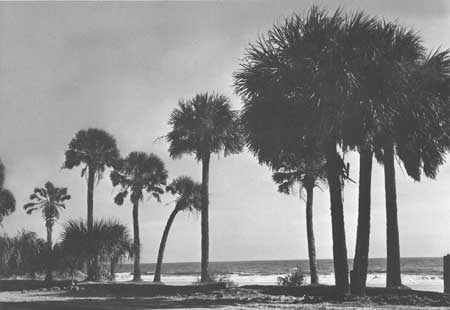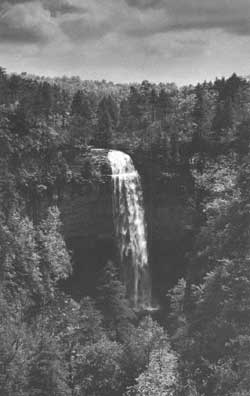.gif)
Parks for America
MENU
|
Parks for America
|

|
THE SOUTH
The 16 States in this census region cover a wide range of physiographic and socioeconomic variations, yet in spite of great diversity, the Southern States have so much in common that they constitute perhaps the most homogeneous section of the United States. The economic and social structure of the area varies from large, fast-growing cities to isolated mountain communities. Outdoor recreation resources include forested mountains, sweeping seashore, eroded canyons, lakes and streams, and huge water impoundments.
Physiographically, mountains and seashore dominate the scene. Hundreds of miles of Atlantic and gulf coastline fall within this region and are fringed with long, narrow barrier beaches and low sea islands. These magnificent beach and coastline qualities have encouraged the creation of such world-famous resorts as those found at Virginia Beach, Myrtle Beach, and Miami Beach.
The Appalachian Mountains, traversing much of the region from northeast to southwest, feature the Blue Ridge Mountains, the Great Smokies, the Cumberland Mountains, and the Alleghenies. The region also has the Ozarks and Ouachita Mountains.
The climate is generally milder than in most of the country. Delightfully cool summers in the Appalachians and Ozarks attract a multitude of vacationers. The ocean surf and the hundreds of miles of smooth sandy beaches attract hordes of visitors to the Atlantic and gulf coasts during the hot summer months. Balmy weather, bright sunshine, and warm ocean currents have made Florida a winter playground of the Nation. In the mountainous regions of the South, the winter months usually produce enough snow and cold weather to encourage the development of winter-sport facilities and the enjoyment of winter scenery
Population distribution and concentrations have particular significance. The region includes a portion of the east coast megalopolis, from Delaware south through the Virginia coastal plain. At the other extreme are sparse populations in parts of Texas and Oklahoma. The pattern of growth is striking. Florida, for example, had the highest rate of increase in the Nation during the last decade, while other parts of the region remained essentially unchanged and will probably continue to grow at a rate well below the national average. Approximately 31 percent of the total population resides in the region.
The economy of this region is perhaps as widely diversified as any—heavy industry, manufacturing, mining, forest products, gas and oil, a diversity of specialized agriculture, and of course shipping along the coast in addition to rail, highway, and river transportation. The outdoor recreation and tourist industry ranks high, especially along the seashore and in the mountain resort country.

|
| From palm-fringed seashore to mountain cataract, the South offers a wide range of park and recreation opportunities. This seascape is of Hunting Island State Park, S.C. (SOUTH CAROLINA STATE COMMISSION OF FORESTRY.) |
While the economy shows healthy growth generally, this region does include some of the most stubborn areas of depressed economy, especially in West Virginia, southwestern Virginia, and eastern Kentucky. In these same sections, however, outdoor recreation is increasingly important, and eventually may make a major contribution in stabilizing the economy. In West Virginia alone, there are resources that if properly preserved and developed will attract many millions of visitors from nearby States. Another economically depressed area includes central and eastern Oklahoma and extends south into eastern Texas. Here outdoor recreation can be one of the principal means of upgrading the economy and in creasing employment.
The pattern of outdoor recreation use accents a desire for water-oriented activities. Because of this the seashore assumes major importance. Inland lakes and streams also provide water-oriented activities, and reservoir impoundments have become firmly established as an essential part of the recreation picture. Also of major importance in the overall recreation picture is the accessibility of the mountain areas with their rushing streams, forested slopes, and abundant wildlife.
Notable tourist attractions of the region include national parks, a national seashore, parkways, and historical areas of outstanding national significance, together with State and local park systems. All of these recreation facilities receive extremely heavy use in season, with the influx of vacationers magnifying the needs in several States for recreation areas and facilities far beyond what would be required by their residents alone. In some instances the greatly in creased need for day- and weekend-use facilities has been recognized and steps have been taken to fulfill these requirements. In other areas, little attention to this pressing problem has been given. This is a region with world-famous vacation objectives, and one in which touring for pleasure has long been popular—keyed to enjoyment of the natural scene, but with strong interest in the rich history which stretches back to the earliest colonial days.
The March 1962 storm along the Atlantic coast wreaked havoc upon structures and the shoreline in general from Delaware and Maryland to the Carolinas. Out of this disaster it is possible that some good may be salvaged if a way can be found to set aside for public recreation those hard-hit areas having outstanding scenic and recreational values.
Private enterprise has played a major role in providing facilities, services, and accommodations to visitors in this region, and will continue to lead in this field as the public demand for recreation opportunities increases. This effort to assist public agencies in meeting recreation needs is especially pronounced on the TVA lakes. In addition, private groups and philanthropic foundations, such as Colonial Williamsburg, Inc., and the Association for the Preservation of Virginia Antiquities, have played a major role in preservation, restoration, and interpretation of historic sites.

|
| Fall Creek Falls State Park, Tenn. (TENNESSEE CONSERVATION AND COMMERCE DEPARTMENT.) |
Public efforts must be stepped up to preserve large areas in a relatively natural condition. The opportunity to do so and to serve urban centers is rapidly passing.
Generally, recreation opportunities are accessible by existing road systems, and it is expected that improvements in the systems will make additional resources accessible as they are developed. The new interstate highways will, of course, provide better access to State recreation facilities for their residents. These routes should also speed tourists from heavily populated areas to distant recreation areas.
Public park and recreation programs vary in terms of diversity and adequacy, but in few, if any, cases can they fully meet the demand. In some respects the balance has been toward preservation of both historical and natural areas, although much still needs to be done.
In general, these are not public land States. The longer history of settlement here has long since foreclosed more of the original natural opportunities than is the case in younger sections of the country. Unfortunately, this is particularly true in relation to the primary outdoor recreation resource of the region—the seashore.
Overall, a few broad conclusions stand out. The overriding need is for open space and outdoor recreation opportunities to serve large concentrations of people, so located and of such diversity that they can become a part of everyday living.
Outstanding natural and historic sites should be acquired promptly where they are not already preserved. These will play some part in meeting needs, but many areas must be selected and developed specifically for the purpose. Along the coast, remaining opportunities are few indeed. Much of the solution, therefore, will lie inland, with a special focus on natural or artificial bodies of water.
The composite plan must be diversified, taking full advantage of many formulas or devices to supplement basic park programs—to recognize the different types and quality of experience people want, and to preserve, so far as possible, an attractive countryside for living.
Planning on an interstate and regional scale is imperative, and the State summaries that follow reflect this concept.
Private enterprise should be encouraged to continue to play a major part. However, public programs play an important role in insuring preservation of significant assets and in providing space and facilities for the simple outdoor activities. These, in most cases, do not represent attractive investment opportunities for private capital.
NEXT >>>
|
|
Last Modified: Mon, Sep 6 2004 10:00:00 pm PDT
parks_america/south.htm
 Top
Top